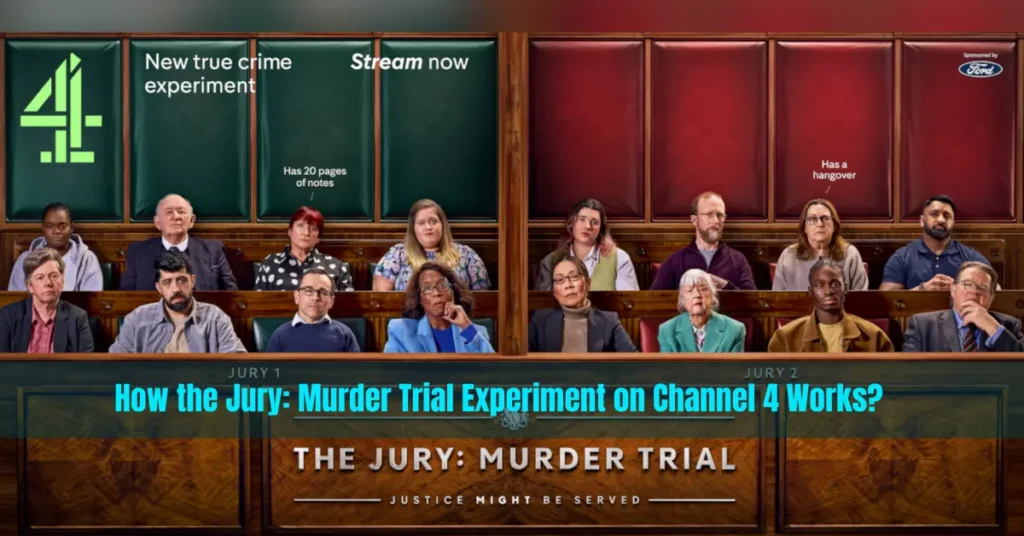The Jury: Murder Trial” is a groundbreaking British docuseries that aired on Channel 4.

What is the Jury Murder Trial?
Channel 4’s landmark docuseries “The Jury: Murder Trial” offered unprecedented insight into the inner workings of the British legal system. This unique social experiment placed the power of a murder verdict into the hands of ordinary citizens, raising questions about how everyday people grapple with the complexities of criminal trials.
The Premise
The show meticulously reconstructed a real-life murder trial where the defendant, a husband, admitted to killing his wife with a hammer but denied the charge of murder. Two separate juries, each composed of 12 randomly selected members of the public, followed the re-enactment of the proceedings. Their task: to determine the defendant’s guilt or innocence.
Inside a Jury Trial
A jury trial is foundational to the UK justice system. Jurors are selected from the electoral register, ensuring a diverse cross-section of society. Their role is to listen carefully to the evidence presented by both the prosecution and defense, including witness testimonies, expert opinions, and physical evidence.
After all evidence is presented, jurors retire to a private room to deliberate. Discussions can be heated as differing perspectives clash. Ultimately, the jury strives towards a unanimous verdict. If they are unable to reach a consensus, a hung jury may be declared, potentially resulting in a retrial.
“The Jury: Murder Trial” Experiment
The Channel 4 experiment aimed to examine how separate groups of people might interpret the same evidence and arguments. Would the two juries reach the same conclusion?
The series captured the jurors’ emotional journeys, revealing their biases, uncertainties, and the weight of the responsibility they shouldered. Viewers witnessed firsthand how subtle shifts in presentation style or the framing of evidence might significantly impact a juror’s perception of the defendant.
The Importance of Impartiality
“The Jury: Murder Trial” underscored the immense challenge of maintaining impartiality within a jury. Jurors must set aside personal opinions and beliefs to arrive at a verdict based solely on the evidence presented in court. The show revealed how difficult this can be, particularly in high-profile cases where emotions run high.
Controversies and Considerations
While the experiment offered valuable insights, it is not without limitations. Some experts argue that a staged trial with actors cannot fully replicate the intensity and stakes of a real-life proceeding. Others raise ethical concerns about potentially influencing future jurors involved in similar cases.
The Takeaway
“The Jury: Murder Trial” serves as a stark reminder of the fallibility of the justice system. It also highlights the crucial role juries play in upholding the principles of fairness and due process. The experiment emphasizes that justice is not always clear-cut and that multiple interpretations of the same event are possible.
While not a perfect reflection of reality, the series sparked important discussions about the complexities of the jury system and the profound responsibility of determining another person’s fate.
Also read: Who Will Be on Celebrity Big Brother 2024? ITV Celebrity Big Brother 2024 Line-Up
What Happened at a Jury Trial?
The “Jury: Murder Trial” docuseries focuses on a re-enactment of a real-life murder trial, not the actual trial itself. However, it provides a valuable glimpse into what typically happens during a jury trial in the UK legal system:
1. Opening Statements:
The prosecution and defense present their opening statements, outlining their respective cases and the evidence they intend to present.
2. Presentation of Evidence:
Both sides present their evidence, which can include:
- Witness testimonies: Witnesses take the stand to provide their firsthand accounts of events related to the case.
- Expert opinions: Experts in various fields, such as forensics or psychology, may offer their interpretations of evidence or shed light on relevant concepts.
- Physical evidence: Tangible evidence, such as photographs, weapons, or DNA samples, is presented to support the arguments of one side or the other.
3. Cross-Examination:
Lawyers for both sides have the opportunity to cross-examine the opposing side’s witnesses, questioning their testimonies and potentially revealing inconsistencies or biases.
4. Closing Arguments:
The prosecution and defense deliver their closing arguments, summarizing their key points and urging the jury to reach a verdict in their favor.
5. Judge’s Instructions:
The judge instructs the jury on legal matters, explaining the law as it applies to the case and outlining the specific criteria they must consider when reaching their verdict.
6. Jury Deliberation:
Jurors retire to a private room to discuss the evidence and arguments presented, aiming to reach a unanimous decision on the defendant’s guilt or innocence.
7. Verdict and Sentencing:
Once the jury reaches a verdict, they return to the courtroom to announce it. If the defendant is found guilty, the judge then determines the appropriate sentence.
The Jury: Murder Trial Experiment’s Focus
While providing a glimpse into the standard trial structure, the docuseries focuses on the jurors’ perspectives and their internal deliberations. It explores how individuals from different walks of life interpret the same evidence and arguments, highlighting the influence of personal experiences and biases on their decision-making processes.
By comparing the two separate juries’ verdicts, the experiment aims to spark meaningful discussions about the complexities of judging and the potential for varying interpretations within the jury system.
How the Jury: Murder Trial Experiment on Channel 4 Works?
Here’s a breakdown of how “The Jury: Murder Trial” experiment on Channel 4 worked:
1. Case Selection:
- The production team chose a real-life murder case where the defendant admitted to killing the victim but denied the charge of murder. This ensured the focus was on the jurors’ interpretation of the evidence and the defendant’s intent rather than establishing whether the crime occurred.
2. Trial Recreation:
- The original trial was meticulously re-enacted using court transcripts, witness statements, and other official records.
- Actors portrayed the defendant, lawyers, witnesses, and other key figures in the trial.
- The courtroom setting was carefully recreated to maintain the authenticity of the experience for the jurors.
3. Jury Selection:
- Two separate juries, each consisting of 12 members of the public, were randomly selected from the electoral register.
- The jurors were completely unaware of the other jury’s existence.
4. Observing the Trial:
- Both juries watched the same re-enacted trial simultaneously in separate locations.
- The jurors were instructed to follow the proceedings closely, paying attention to all the evidence and arguments presented by both the prosecution and the defense.
5. Deliberation and Verdict:
- After the trial concluded, each jury was sequestered to deliberate in private.
- Jurors discussed the evidence, debated their interpretations, and worked towards reaching a unanimous verdict on whether the defendant was guilty of murder.
- Cameras captured the deliberation process, revealing the jurors’ thought processes, biases, and how they navigated potentially conflicting opinions.
6. Comparison and Analysis
- The heart of the experiment lay in comparing the two juries’ verdicts. Did they reach the same conclusion? If not, what factors may have influenced their contrasting decisions?
- The series provided commentary and analysis from legal experts, psychologists, and other professionals to shed light on the dynamics of jury decision-making and the potential for differing interpretations of evidence.
Key Takeaways from the Experiment
- The complexity of evidence: The show highlighted how the presentation of evidence, subtle nuances in testimony, and even word choice can significantly shape a juror’s perception of a case.
- The weight of responsibility: Jurors grappled with the enormity of deciding someone’s fate, showcasing the emotional and psychological toll of jury service.
- The importance of impartiality: It exposed how difficult it can be for jurors to remain completely impartial, demonstrating the potential for personal biases and life experiences to influence their interpretations.
Where to Watch The Jury Murder Trial?
Here are a few ways you might be able to watch “The Jury: Murder Trial”:
- Channel 4 (All 4): The most likely primary source will be Channel 4’s streaming platform “All 4”. Check there for on-demand access to the show’s episodes.
- Third-Party Streaming Services: “The Jury: Murder Trial” might be available on other popular streaming platforms. Search on services you subscribe to to see if it’s been picked up by other providers.
- Purchase Options: Depending on its popularity, the show might become available for purchase through services like:
- Amazon Prime Video
- iTunes/Apple TV
- Google Play Store
Important Note: The availability of “The Jury: Murder Trial” may vary based on your location and licensing agreements.
FAQs
1. What is “The Jury: Murder Trial?”
It’s a British docuseries that aired on Channel 4, where two separate juries deliberated on a re-enactment of a real-life murder trial.
2. What’s the purpose of the experiment?
The experiment aimed to explore how different people interpret evidence, manage personal biases, and reach verdicts in a criminal trial.
3. How were the juries chosen?
Twelve jurors were randomly selected from the public for each of the two juries. They remained unaware of the other jury’s existence.
4. What was the real-life case like?
The re-enacted case involved the defendant admitting to killing the victim but denying murder charges. This allowed the focus to be on how the juries interpreted the evidence and intent, not the occurrence of the crime itself.
5. What were the results of the experiment?
The show focused on comparing the verdicts of the two juries, revealing both their similarities and discrepancies. This sparked discussions about the complexities of jury decision-making and the potential for varying interpretations within the system.
Content Contributor: Amrita Mridul









